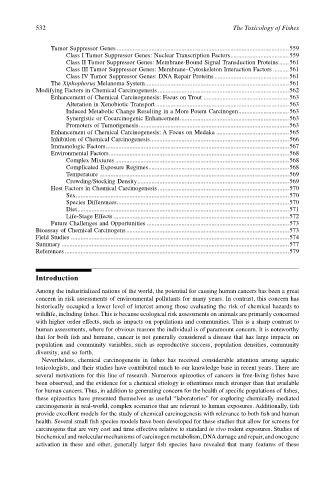Page 552 - The Toxicology of Fishes
P. 552
532 The Toxicology of Fishes
Tumor Suppressor Genes .............................................................................................................559
Class I Tumor Suppressor Genes: Nuclear Transcription Factors.....................................559
Class II Tumor Suppressor Genes: Membrane-Bound Signal Transduction Proteins ...... 561
Class III Tumor Suppressor Genes: Membrane–Cytoskeleton Interaction Factors .......... 561
Class IV Tumor Suppressor Genes: DNA Repair Proteins...............................................561
The Xiphophorus Melanoma System...........................................................................................561
Modifying Factors in Chemical Carcinogenesis...................................................................................562
Enhancement of Chemical Carcinogenesis: Focus on Trout ......................................................563
Alteration in Xenobiotic Transport ....................................................................................563
Induced Metabolic Change Resulting in a More Potent Carcinogen................................ 563
Synergistic or Cocarcinogenic Enhancement.....................................................................563
Promoters of Tumorigenesis...............................................................................................563
Enhancement of Chemical Carcinogenesis: A Focus on Medaka ..............................................565
Inhibition of Chemical Carcinogenesis........................................................................................566
Immunologic Factors....................................................................................................................567
Environmental Factors..................................................................................................................568
Complex Mixtures ..............................................................................................................568
Complicated Exposure Regimes.........................................................................................568
Temperature ........................................................................................................................569
Crowding/Stocking Density................................................................................................569
Host Factors in Chemical Carcinogenesis...................................................................................570
Sex.......................................................................................................................................570
Species Differences.............................................................................................................570
Diet......................................................................................................................................571
Life-Stage Effects ...............................................................................................................572
Future Challenges and Opportunities ..........................................................................................573
Bioassay of Chemical Carcinogens.......................................................................................................573
Field Studies ..........................................................................................................................................574
Summary ................................................................................................................................................577
References..............................................................................................................................................579
Introduction
Among the industrialized nations of the world, the potential for causing human cancers has been a great
concern in risk assessments of environmental pollutants for many years. In contrast, this concern has
historically occupied a lower level of interest among those evaluating the risk of chemical hazards to
wildlife, including fishes. This is because ecological risk assessments on animals are primarily concerned
with higher order effects, such as impacts on populations and communities. This is a sharp contrast to
human assessments, where for obvious reasons the individual is of paramount concern. It is noteworthy
that for both fish and humans, cancer is not generally considered a disease that has large impacts on
population and community variables, such as reproductive success, population densities, community
diversity, and so forth.
Nevertheless, chemical carcinogenesis in fishes has received considerable attention among aquatic
toxicologists, and their studies have contributed much to our knowledge base in recent years. There are
several motivations for this line of research. Numerous epizootics of cancers in free-living fishes have
been observed, and the evidence for a chemical etiology is oftentimes much stronger than that available
for human cancers. Thus, in addition to generating concern for the health of specific populations of fishes,
these epizootics have presented themselves as useful “laboratories” for exploring chemically mediated
carcinogenesis in real-world, complex scenarios that are relevant to human exposures. Additionally, fish
provide excellent models for the study of chemical carcinogenesis with relevance to both fish and human
health. Several small fish species models have been developed for these studies that allow for screens for
carcinogens that are very cost and time effective relative to standard in vivo rodent exposures. Studies of
biochemical and molecular mechanisms of carcinogen metabolism, DNA damage and repair, and oncogene
activation in these and other, generally larger fish species have revealed that many features of these

